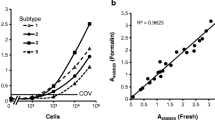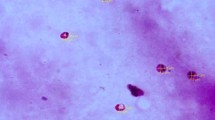Abstract
Dientamoeba fragilis, a trichomonad parasite is usually found in the gastrointestinal tract of human, and it is known to be the cause for gastrointestinal disease. The parasite is globally distributed and mostly found in rural and urban areas. The parasite is found in humans and nonhuman primates such as the macaques, baboons, and gorillas. Often, the parasite is confused with another largely found organism in stools called Blastocystis sp. especially when seen directly under light microscopy on culture samples containing both parasites. Both sometimes are seen with two nuclei with sizes tending to be similar which complicates identification. Stools were collected fresh from nine previously diagnosed persons infected with D. fragilis who also were found to be positive for Blastocystis sp. Samples were then cultured in Loeffler’s medium and were stained with Giemsa, iron hematoxylin, and modified Fields’ (MF) stain, respectively. D. fragilis was differentiated from Blastocystis sp. when stained with MF stain by the presence of a thinner outer membrane with clearly demarcated nuclei in the center of the cell whilst Blastocystis sp. had a darker and thicker stained outer membrane with the presence of two nuclei. The staining contrast was more evident with modified Fields’ stain when compared with the other two. The simplicity in preparing the stain as well as the speed of the staining procedure make MF stain an ideal alternate. The modified Fields’ stain is faster and easier to prepare when compared to the other two stains. MF stain provides a better contrast differentiating the two organisms and therefore provides a more reliable diagnostic method to precisely identify one from the other especially when cultures show mixed infections.


Similar content being viewed by others
References
Afzan MY, Sivanandam S, Kumar GS (2010) Modified Field’s staining—a rapid stain for Trichomonas vaginalis. Diagn Microbiol Infect Dis 68(2):159–162
Banik GR, Birch D, Stark D, Ellis JT (2012) A microscopic description and ultrastructural characterisation of Dientamoeba fragilis: an emerging cause of human enteric disease. Int J Parasitol 42(2):139–153
Barratt J, Banik G, Harkness J, Marriott D, Ellis J, Stark D (2010) Newly defined conditions for the in vitro cultivation and cryopreservation of Dientamoeba fragilis: new techniques set to fast track molecular studies on this organism. Parasitol 137(13):1867
Cacciò SM et al (2012) Pigs as natural hosts of Dientamoeba fragilis genotypes found in humans. Emerg Infect Dis 18(5):838
Chan F, Guan M, Mackenzie A (1993) Application of indirect immunofluorescence to detection of Dientamoeba fragilis trophozoites in fecal specimens. J Clin Microbiol 31(7):1710–1714
Crotti D, Sensi M, Crotti S, Grelloni V, Manuali E (2007) Dientamoeba fragilis in swine population: a preliminary investigation. Vet Parasitol 145(3):349–351
Norberg A, Nord C, Evengård B (2003) Dientamoeba fragilis—a protozoal infection which may cause severe bowel distress. Clin Microbiol Infect 9(1):65–68
World Health Organization (WHO) (1992) Bench aids for the diagnosis of intestinal helminths. Geneva: World Health Organization
Stark D, Barratt J, Van Hal S, Marriott D, Harkness J, Ellis J (2009) Clinical significance of enteric protozoa in the immunosuppressed human population. Clin Microbiol Rev 22(4):634–650
Stark D, Beebe N, Marriott D, Ellis J, Harkness J (2005) Prospective study of the prevalence, genotyping, and clinical relevance of Dientamoeba fragilis infections in an Australian population. J Clin Microbiol 43(6):2718–2723
Stark DJ, Beebe N, Marriott D, Ellis JT, Harkness J (2006) Dientamoebiasis: clinical importance and recent advances. Trends Parasitol 22(2):92–96
Yakoob J et al (2010) Blastocystis hominis and Dientamoeba fragilis in patients fulfilling irritable bowel syndrome criteria. Parasitol Res 107(3):679–684
Acknowledgments
The study would not have been possible without the support of HIR grant UM.C/625/1/HIR/044 and student grant PG095-2013B
Financial competing interest
The authors declare that they have no competing interests.
Author’s contribution
ADR and SKG were involved in all stages of the study, including concept and design of the experiment, data collection and analysis, and interpretation of results. ADR wrote up the manuscript, and all authors read and approved the finalized manuscript.
Author’s details
Department of Parasitology, Faculty of Medicine, University of Malaya, 50603, Kuala Lumpur, Malaysia
Conflict of interest
The authors have no conflict of interest. The authors do not have a commercial or other association that has a conflict of interest.
Author information
Authors and Affiliations
Corresponding author
Rights and permissions
About this article
Cite this article
Ragavan, A.D., Govind, S.K. Modified fields’ stain: ideal to differentiate Dientamoeba fragilis and Blastocystis sp.. Parasitol Res 114, 1163–1166 (2015). https://doi.org/10.1007/s00436-014-4296-8
Received:
Accepted:
Published:
Issue Date:
DOI: https://doi.org/10.1007/s00436-014-4296-8




